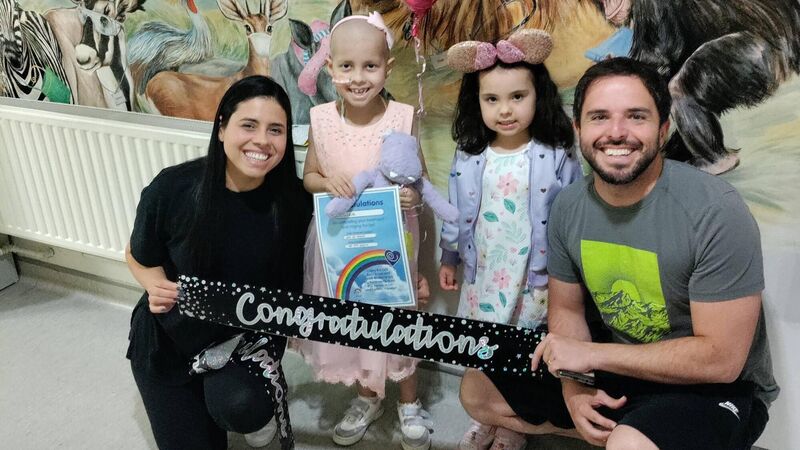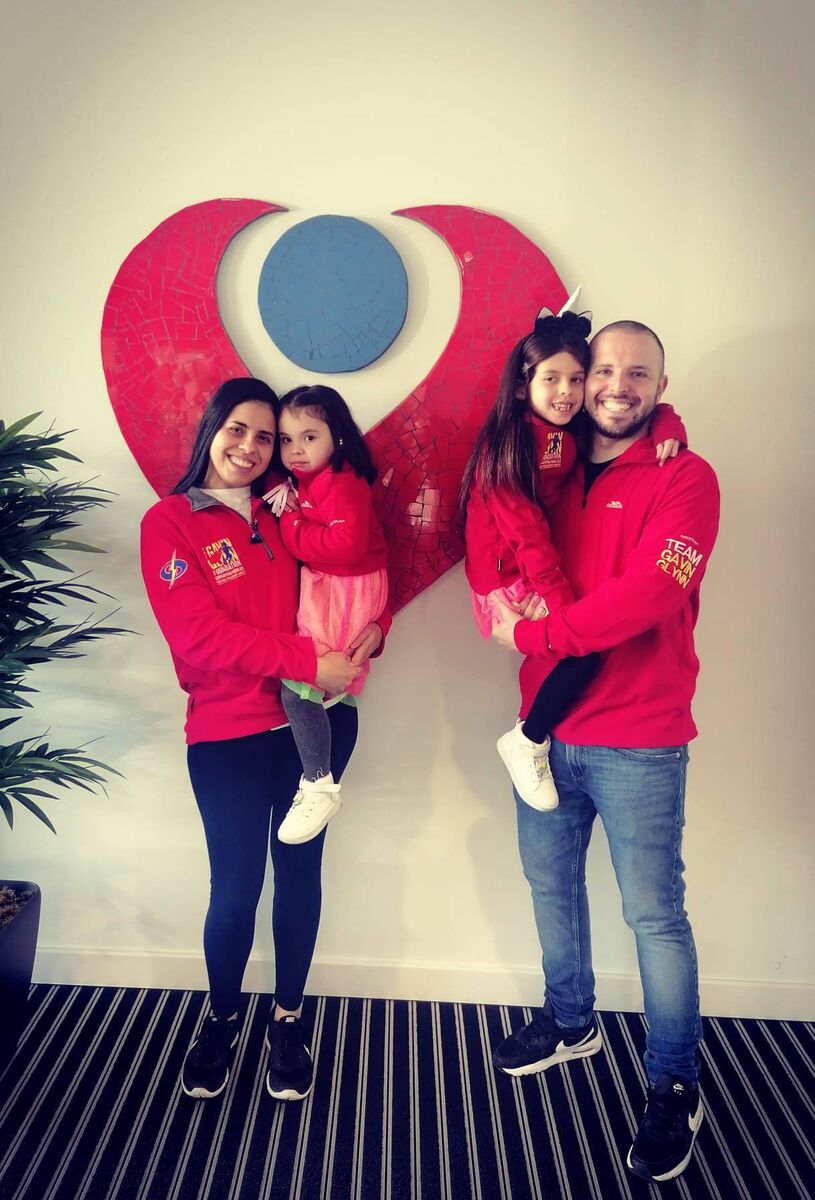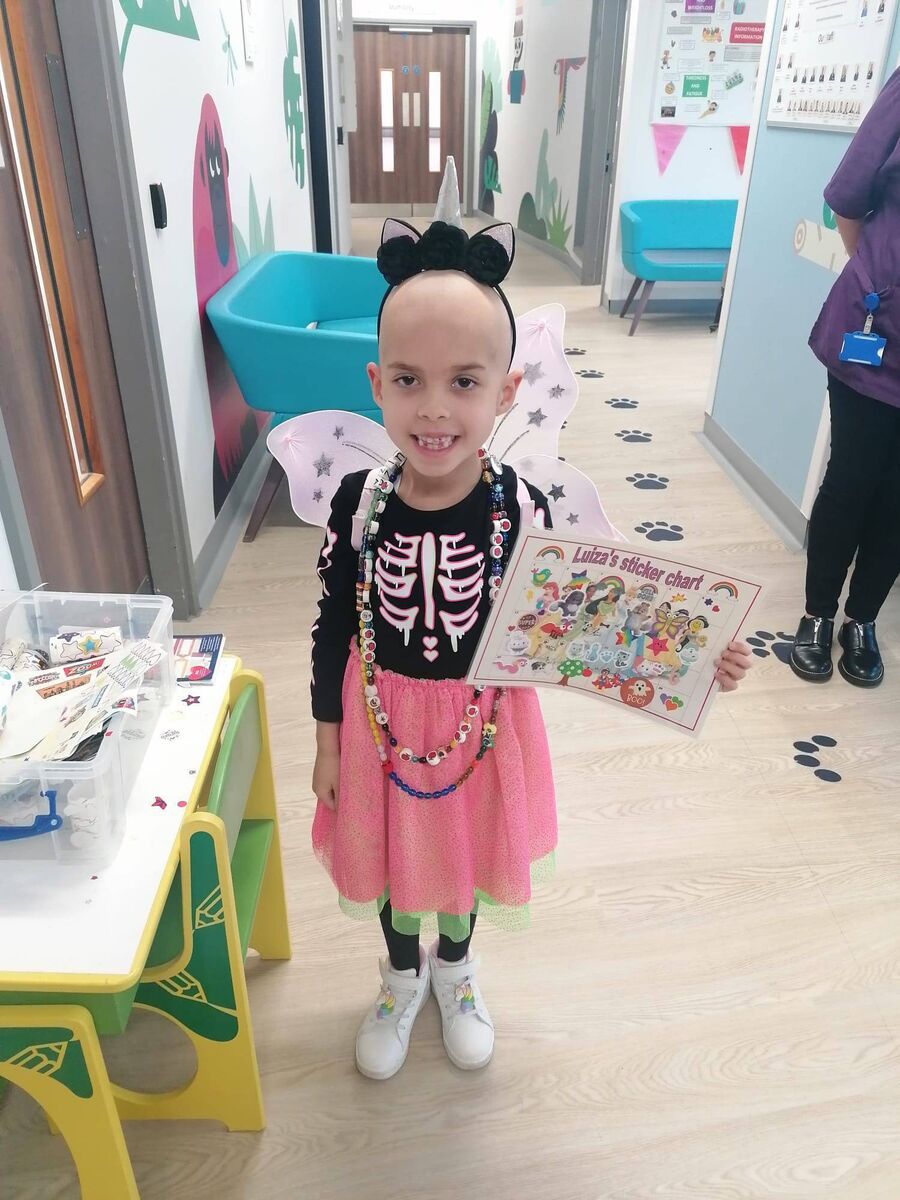'I thought my six-year-old daughter had a vomiting bug — it was a brain tumour'

Luiza Bertunes Zaboto (second left) with her mum Regiane, sister Helena and dad Leonardo, following the conclusion of chemotherapy treatment in CHI Crumlin in August 2024
Two years ago, when Regiane Zaboto’s then six-year-old daughter Luiza began complaining of pain in her legs, got a fever, and was tired, the mother of three was not overly concerned.
“It was summer, when all kids seem a bit more tired, and lots of bugs were going on in the crèche, so it didn’t really alarm us until the other symptoms started,” says Limerick-based Regiane.
Both she and her husband, Leandro, are managers in the IT sector.
Luiza vomiting in the morning, before she had eaten, was the first alarming symptom. “She was vomiting on an empty stomach,” Regiane says.
“I thought maybe it was the vomiting bug I’d heard people talk about. The GP prescribed medication to help her empty her intestines. She didn’t improve. It would happen maybe two days a week.”
Regiane and Leandro began seeing other unusual symptoms.
“She was closing her left eye to watch TV. And, walking home from crèche, she was turning her head sideways to talk to me, so that she could see me with her right eye. Her balance was off, too; she was tripping, not seeing stuff on the floor.”
A “frightened” Regiane was considering having Luiza referred to an ophthalmologist.
But the GP sent her to the emergency department at University Hospital Limerick. Eye tests showed that her vision was 100%, but also indicated inflammation on the nerve of her eye.
“They sent her for MRI to check better what was going on in her head. At that point, I felt something more serious could be going on: I had a bad feeling.”

Luiza was diagnosed with a medulloblastoma brain tumour. With Leandro at home looking after their younger daughter, Helena, Regiane was in shock.
“When they said it was a tumour, I went blank. I couldn’t talk, cry or do anything. I sat there, quiet. They asked ‘Do you have any questions?’ I couldn’t formulate questions. They suggested calling my husband. And, in telling him, I cried, I couldn’t stop — everything came at me then.
"But, as a parent, I knew I had to make myself strong for Luiza. I wiped my face, but she knew something was wrong. She said ‘What’s happening?’ They were transferring us straightaway to Temple St, so I said she had to go for more tests in another hospital and Daddy was coming, and she took what I said and was calm.”
“Such a diagnosis is terrifying. You have to keep bad thoughts away, but in my head the only thought was ‘My daughter is dying, Helena’s going to lose her sister’.”

At Temple St Luiza underwent further MRI to identify the tumour size and location. She needed surgery to remove the tumour and to drain fluid from her brain.
“At first, I was saying ‘If you can take it out, take it out’. But the day before surgery the doctor explained all the things that could go wrong. For example, when she came back from surgery she could be a different person, not herself anymore. After that, we panicked.”
But the doctors said that Luiza was not as sick as she might have been with this kind of tumour. “Usually, the child has episodes of fainting, epilepsy, black-outs. Luiza didn’t. Hearing that helped a lot.”
Within a week, Luiza underwent six-hour surgery. Her parents waited in a hotel: “The call came. We were told she was in the recovery room; we could see her. They said everything went great; the surgery was a success. But going into the hospital, we were so afraid of what we’d find; maybe she wouldn’t be able to talk or swallow straightaway.”
Instead, they found Luiza awake and speaking both Portuguese and English. “It was such a relief. She was being monitored and they were continuing to draw fluid from her brain; they were concerned she’d need a shunt, but she didn’t.”
The next stages of Luiza’s treatment involved six weeks in Manchester for proton beam therapy, a type of radiotherapy that aims high-energy protons directly at the tumour.

This was followed by chemotherapy from November 2023 to August 2024. She now attends for MRI every three months.
“Every MRI is hard for us. But we’re very optimistic. We’ve been told chance of recurrence for this type of tumour is very low; we believe in that and stay focused and strong,” says Regiane, also mother to three-month-old Clara.
Today, Luiza, now eight, is in great form.
“We just need to keep an eye on her balance. Because of the type of surgery and where the tumour was, it affected her balance. But it’s something she can work on and improve; it’s a very small thing. She’s a very active, smart little girl. She does Irish dancing, gymnastics, swimming. She goes to school full-time. We feel blessed.”
Approximately 65 children and young people are diagnosed with a brain or central nervous system (CNS) tumour each year in Ireland. In the decade up to 2020, brain and CNS tumours were the most common childhood cancer, accounting for 27%, alongside leukaemia (also 27%).
John Caird, paediatric neurosurgeon at CHI Temple St says diagnosing as quickly as possible for patients is an ongoing concern for medics: “Sometimes, people are seen in general practice and the emergency department and are sent home with a diagnosis of migraine or virus. Only when very ill would a scan be performed. So we’re trying to raise awareness, both with GPs and emergency department doctors, that, if somebody presents with symptoms, to undertake a scan.”
Caird says delayed diagnosis can be due to initial signs being very subtle and symptoms common to many other ailments.
“For example, it’s common to get headaches and we don’t normally think of brain tumour when someone gets a headache. But the take-home message for parents, for GPs, and emergency departments is that if a child is presenting with symptoms that aren’t settling down, that are prompting re-attendance to the doctor again and again and that are not otherwise explainable, the possibility of brain tumour must be considered.”

Caird outlines the symptoms: “A baby may have a bigger head. Young children and teenagers may get seizure, visual problems, headaches and vomiting. Some children may also go in to premature puberty at four or five years of age, due to hormonal imbalance caused by a brain tumour. People can appear entirely well and may just have symptoms from time to time — but recurrent headaches and vomiting should be investigated.”
Consultant paediatric oncologist at CHI Crumlin, Dr Jane Pears, is also urging doctors to consider brain tumours when reviewing symptoms: “Unfortunately, there’s a recurring theme in brain-tumour diagnosis, where patients would have gone with something wrong a few times to their GP or to A&E, but getting to diagnosis can take some time and have consequences, such as loss of sight. It doesn’t necessarily mean the outcome is worse for those who have a longer timeframe to diagnosis, but it can be; a person may have, unfortunately, lost vital functions by the time the diagnosis is made.”
While brain tumour is rare in children, it is, nevertheless, the most common solid tumour in oncology in children. “I’d encourage people to get to know the range of symptoms, which can include the fontanelle being tense and elevated in babies, rather than soft and flat, or a change in
handwriting or educational ability for older kids.”
Pears suggests parents ask their doctor: Can you reassure me this isn’t a brain tumour?
- To mark National Brain Tumour Awareness Week, October 20 to 26, Brain Tumour Ireland’s ‘Heads Up’ campaign highlights brain-tumour symptoms in children and teens. They have developed a guide for members of the public on identifying the symptoms that can arise for babies, children age five to 11 years, and teens up to 18 years.
- A webinar on supporting children with a brain tumour takes place on Monday, October 20, 6pm-7.30pm. To register for this event, to download the ‘Heads Up’ guide, and for full details on all events taking place as part of the week, visit: braintumourireland.com






